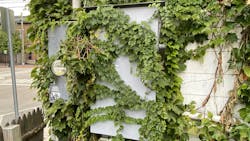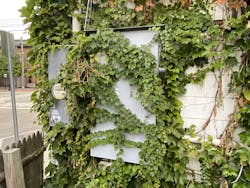All references are based on the 2023 edition of the NEC.
Problems at the Pool
If you look closely at the photo, you may notice the gray PVC junction box directly above the underwater light and in the dirt just outside the concrete wall of the pool. That junction box is not the correct type of box and cannot be located there.
Junction boxes connected to a conduit extending directly to the forming shell of a wet-niche light or the mounting bracket of a no-niche light must be listed, labeled, and identified as a swimming pool junction box as specified in Sec. 680.24(A)(1). As for the location of the box, it is required to be placed no less than 4 ft horizontally from the inside wall of the pool in accordance with the provisions of Sec. 680.24(A)(2). For luminaires operating above the low-voltage contact limit as defined in Art. 100, Sec. 680.24(A)(2)(a) requires the junction box to be located no less than 4 in. above the ground or pool deck or no less than 8 in. above the maximum water level of the pool — whichever is higher. For low-voltage luminaires, Sec. 680.24(A)(2)(c) permits boxes to be installed flush with the deck if the box is filled with a potting compound and is located no less than 4 ft from the inside wall of the pool. This box is installed way too close to the pool!
A Disappearing Act
If those vines keep growing, it won’t take long for the service disconnect and the metering equipment to be completely enveloped and unrecognizable. I feel bad for any workers needing to work on that disconnect, especially if there is any poison ivy growing amongst those vines. I’m itchy just thinking about it.
While this installation may have complied with Sec. 230.70(A)(1) requirements to be “readily accessible” when it was initially installed, the vines and other vegetation growing all over the side of this building currently create obstacles that would need to be removed in order to access the equipment. This equipment is no longer “readily accessible.” Would a person be able turn off the power quickly in an emergency? Or would those vines restrict the movement of the disconnect handle? There are not many Code rules written about vegetation, but installers must be aware of the surroundings and the possibility of any future vegetation growth that may create problems or hazards for the electrical installation. In this case, the vegetation should be cut back and maintained in a manner that permits safe, Code-compliant access to this electrical equipment.
About the Author

Russ LeBlanc
Owner
Russ started in the electrical trade as an apprentice in 1985. He worked his way up to become a Journeyman Electrician and then eventually became a Master Electrician and Licensed Construction Supervisor. In 1999 Russ become an Electrical Instructor for The Peterson School of Engineering in Massachusetts where he developed his passion for teaching, and quickly became Department Head of Electrical Instruction. Russ has taught thousands of apprentices, electricians, engineers, inspectors, and other electrical professionals during his career as an instructor. He continues to provide electrical professionals with Electrical Code seminars, Arc-Flash Awareness training seminars and educational material through his LeBlanc Consulting Services in North Reading, MA whose specialty is educating electricians. He has been an active member of the NFPA Electrical Section and has authored hundreds of National Electrical Code proposals and comments which have become Code rules to improve the safety for the electrical industry. Russ is also an IAEI certified Electrical Inspector.
Please visit www.russleblanc.net for more information.


